Petroglyphs at Altavista
Known in Mexico as "La Pila del Rey", "Chacalán", "El Santuario", "Los Petroglˇfos" or "the Altavista petroglyphs", this is an archeological and scenic attraction near Jaltemba Bay. More than two thousand years ago an Aztecan tribe, the Tecoxquines, chipped images into the volcanic rock along the arroyo (seasonal stream) Las Piletas. The petroglyphs are believed to be symbolic of the concerns and the yearnings of the people, for health and fertility, the return of the rains, and successful crops. The rock carvings might have been meant as prayers or offerings to the gods responsible for these things. After the arrival of the Conquistadors in the early 16th century, the twin scourges of disease and forced servitude led to the extinction of the Tecoxquin. Today the site of the petroglyphs holds religious significance for the native Huichol. Archeologists have located more than 2000 carvings in an area of more than 80 hectares (200 acres); the casual visitor can see seventy or more without too much effort. A series of fifteen signs in Spanish and English are posted along the path, giving some explanation and historical context to the site. Beyond seeing these artifacts of an ancient society, a visit to the petroglyphs will lead you on a pleasant walk through tropical forest. Perhaps a kilometer from the entrance, you'll reach the most sacred area of this site. See an AIR VIEW. Las Piletas creek flows down over a series of rock shelves and through small pools it has carved over the eons; beside it are high vertical walls of basalt covered with ferns, Philodendrons, and other forest plants. All around and above are native palms, trees with flaking red bark, bromeliads, and other flora of the tropical forest. The greatest concentration of carvings is here. This is a peaceful, magical place to sit and contemplate, listen to the water flowing over the rocks, watch the butterflies, and wander about.
Near a place of offerings in this beautiful sanctuary stands
a Ceiba tree, the most important tree of the Aztecs and the
Mayans and other ancient Mesoamerican people; joining all the
creatures of earth with the water world below the surface and
the world of the gods above. If you want to visit the site, use the MAP PROVIDED HERE. Keep in mind that this site is still in use for native religious practices. Don't take food or drink with you when you enter. Come interested, come open to the experience, and come quietly. |
1) AltavistaArcheological Petroglyphs site of Altavista known as "La Pila del Rey" located along the Piletas creek on the sides of the Copo volcano. It covers an extension of about 80 hectares where there is one of the biggest concentrations of engraved rocks.
2) The Tecoxquin ("Throat-Cutters")They were the original users of the Altavista site. Long before the Spanish, this indigenous group inhabited an extensive region covering the entire southern coast of Nayarit and neighboring coastal and mountain regions of Jalisco. They were mainly farmers, fishermen, salt-producers, and traders in cacao and cotton. The Tecoxquines were organized in a series of villages under the control of Teuzacualpan in the Chila valley (the modern-day town of Zacualpan). Their commercial links allowed them to establish an intense trade which reached at least as far as southern Sinaloa, and as far south and east as Colima and Michoacan.
3) The Tecoxquines Religious LifeMany of the religious ceremonies which occurred at this site were undoubtedly based on nahualism. Nahualism, or shamanism, is an ancient religious practice by which certain persons communicate with their gods and spirits through altered states of consciousness. This tradition has deep roots in the region; the name of the state of Nayarit derives from the word "nahualli". The Tecoxquines used psychotropic plants and tobacco to attain states of ecstasy that brought them into contact with their deities.
4) The Last Of The TecoxquinesIn 1524 an army led by Francisco Cortes de Buenaventura incorporated this zone into the jurisdiction of Santiago of Colima. Six years later, Nuño de Guzman formed the kingdom of Nueva Galicia covering the entire northern and western regions of Mexico. Following the Spanish conquest, deaths from epidemics and forced labor completely annihilated the Tecoxquines as a people. Today in the mestizo towns of the area people still speak of "white indians," ghosts who appear from the mountains to honor their ancient gods.
5) The TecualesIn the 17th century, European landowners cultivating cacao in the region needed a new workforce. The old Tecoxquin villages, as far as the salt-producing town of Ixtapa were populated with Tecual who were ancestors of the modern-day Huichol. A new wave of Europeans arrived from the town of Compostela and formed haciendas such as Chila and Las Varas. They also brought in slaves through the nearby port of Chacala which had trade links with North and South America. Each of these new peoples reinterpreted the petroglyphs of Altavista in a distinct manner
6) The Water CycleThe state of Nayarit is characterized by high rainfall, the fifth highest in the country. The rains are concentrated in a period of intense storms between May and October. In dramatic contrast to the dry season the rest of the year, the mountains of Altavista attract heavy rainfall leaving the areas to the east much drier (the opposite side of the mountain has a semi-desert climate). Perhaps becuase of this abundance of water, Altavista was seen as a special place, and venerated for its fertility
7) TamoanchanThis concept was a central part of ancient mesoamerican cosmology. Tamoanchan is the cosmic tree which connects all life and sustains the world. Its roots are underground in the realm of water and fertility. Its trunk is among humans above ground and reaches upward. The crown of the tree is in the heavens, in the realm of the gods and the rains. Tamoanchan was represented by the Ceiba tree in many parts of Mexico although other large trees such as the pine and the strangler fig could also have served the same purpose.
8) Warfare: Trophy HeadsThe "flower war" was one of the principal religious practices associated with the Tecoxquines . The goal was not conquest. Rather the objective was to obtain warrior prisoners for ritual sacrifice, and whose severed heads were later offered to the gods. These wars usually occurred locally, although they were also held in places as far away as the valleys of Talpa, Mascota, and the Mochitiltic Canyon in Jalisco.
9) TlalocanIn ancient Mesoamerica, water was thought to lie underneath the earth, and so the underworld was considered a place of fertility. Tlalocan was the "water paradise" beneath the earth. It was inhabited by the Chanes, or Water Spirits, as well as the spirits of those people who had drowned or whose death was connected to water. Tlalocan was also the place of the mythical crocodile Cipactli, an "earth monster" who symbolized fertility and the primordial times
10) The Devoted ChristThe first historical references to the Altavista archeological site date from 1612. They describe complex writing, a multitude of crosses, and above all a devoted Christ whom the local people hold in great veneration. This is possibly a reference to the so-called "Maize Man", a figure symbolizing fertility and growth. Local farmers leave offerings of candles and gourd bowls of salt to this figure in order to obtain fertility for their coffee and tobacco crops or in hopes of obtaining work when they travel to the United States.
11) The Apostle MatthewBeginning in the 17th century the belief arose among the Spanish that the apostle Matthew traveled to the new world in prehispanic times to evangelize the indians. This was thought to account for the rock carvings of Altavista, especially the crosses. By the 20th century this belief had developed to the point where Matthew was credited with creating the cross of grass, which is now a religious sanctuary in Tepic and is thought to possess miraculous powers. According to local legend a stream of blood beginning at the cross of grass flowed down the mountains to Altavista, connecting the two sacred sites.
12) The CrossThe fact that the cross was a sacred symbol among the Tecoxquines, somewhat surprising to the Spanish, and led to the legend of the apostle Matthew. But for the Tecoxquines, like most other ancient mesoamericans, the cross was in reality a mental map of the cosmos. It symbolized the five sacred directions: the four cardinal points and the center. Each direction was associated with certain gods, colors, and sacred realms, as well as one of the four trees which formed the tamoanchan. The idea of the four-cornered universe is still present among Mexican indians today, and is symbolized by crosses, diamonds and other similar shapes.
13) Communication With The GodsIt is possible that the rocks of Altavista were associated with the mythical trees of Tamoanchan which connected the underworld, the earth and the heavens. The prayers of the people traveled up through the sap of the tree trunks to the realm of the gods. In turn, the gifts of the gods, rain, fertility, and good health returned to the earth through the same trees. For the Tecoxquines , the rocks of Altavista would have served the same purpose, a medium of communication between the people and their gods.
14) Tecoxquin SymbolismThe spirals, wavy lines and other symbols carved in the rocks of Altavista most likely constitute a ritual language of prayers to the Tecoxquin gods. As an agricultural people, the Tocoxquines would have been concerned with obtaining rain, fertility of the earth, and the continuance of the seasonal rhythms they depended upon. Although the exact meaning of the symbols will never be known, the spirals have been interpreted as the sun, rainstorm, wind, coiled snakes, or as a symbol of the natural rainy and dry cycle
15) Huichol OfferingsThe Huichol indians who occasionally visit Altavista originally lived in the mountains of Nayar although in recent years a small group has moved to the Las Varas area. They leave offerings and perform ceremonies here for Nakahue, "our grandmother of fertility," and also for Tatevari, "our grandfather of fire". Some Huichols also travel to the nearby port of Chacala where ancient rock carvings are located and leave offerings to Tatei Aramara, "our mother ocean." |
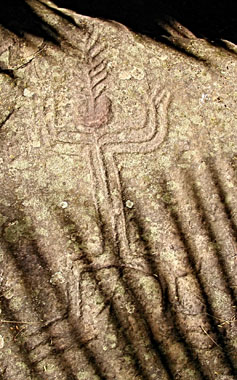 |
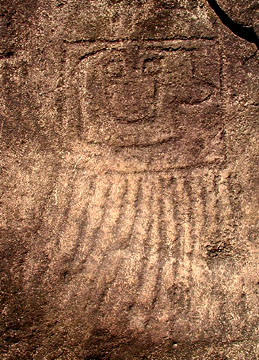 |
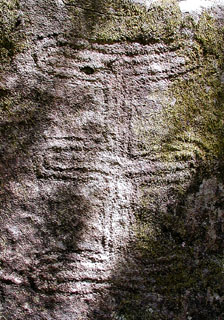 |
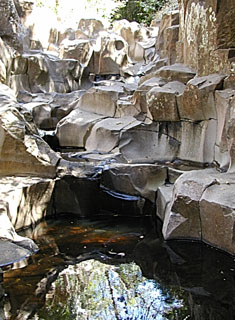 |
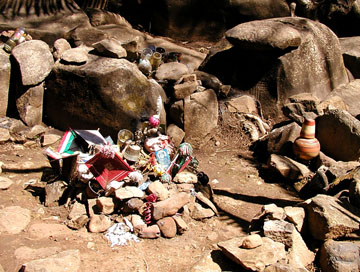 |
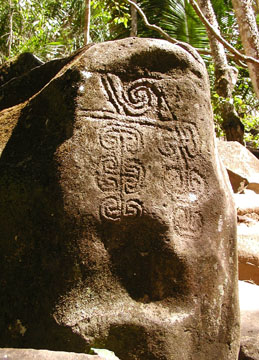 |
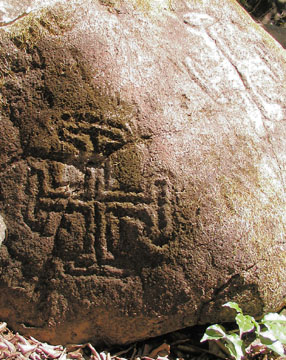 |